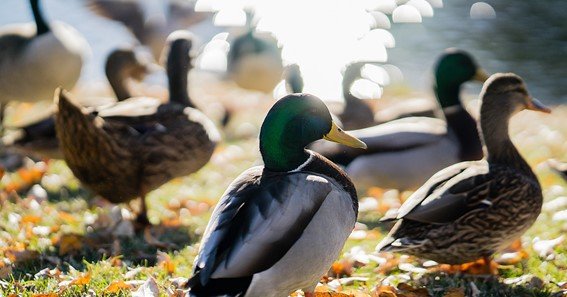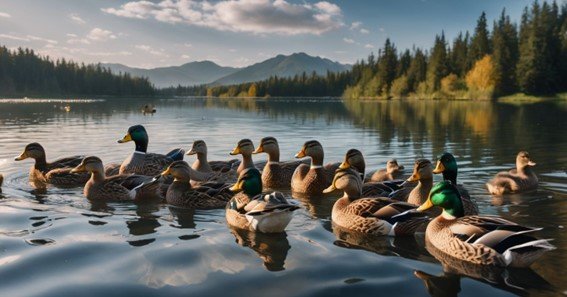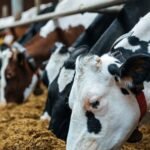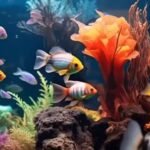What is a group of ducks called? A group of ducks is commonly called a “flock.”Hearing ducks call is a pleasant and unique sight that illustrates how these tiny birds interact. From calm ponds and busy rivers to metropolitan parks and seashore marshes, ducks are simple to recognize with their waddles and quacks. Ducks are fun to watch and may teach you about their behavior, communication, and relationships. How do you describe these duck groupings, and why are they so intriguing? In this article we discuss about what is a group of ducks called and more about it.
What Is A Group Of Ducks Called?
A group of ducks is commonly called a “flock.” People call ducks a “flock.” People use this word to describe flying or walking duck flocks. When ducks are on the water, language becomes more specific. Others name them “raft,” “team,” or “paddling,” each describing a distinct aspect of their behavior and environment. Ducks fly as a “flock.” They have coordinated flight patterns and generally fly in V-shapes, which helps them migrate faster and save energy.
Things To Keep In Mind When Facing A Group Of Ducks

There’s more to ducks’ behavior than meets the eye. Look at different sections of a duck group to see how they communicate, interact, and change their environment. After reading about what is a group of ducks called, now learn about these fascinating bird groups.
Terminology Changes
Where and what ducks are doing determines their description. “Flock” is the most common word, but “raft,” “team,” and “paddling” describe their water activities. This shows how ducks adapt to their environment and behave differently. The word “raft” reminds me of ducks gathering on the river to feel comfortable and part of a group.
Society’s Operation
Duck groups have precise norms for getting along. The group needs this framework to be organized and function well. Dominant ducks lead the group on feeding, rest, and travel decisions. This type of leadership involves power, noise, and contact. Social structure keeps duck groups intact and reduces fighting. The most experienced will lead, increasing their chances of survival and helping them find their path. Ducks underneath the dominant ducks stay safe by following their path.
Migration Patterns
After reading about what is a group of ducks called, you must know many duck species travel far in groups. They move because the seasons change, and need excellent breeding and wintering grounds. Ducks travel thousands of kilometers, often across nations, to find the ideal breeding areas. Group migration is advantageous. The group reduces energy utilization and enhances guidance accuracy. Ducks often fly in Vs. Lowering air pressure saves energy. Ducks migrate together, demonstrating their efficiency and teamwork.
Interacting
Ducks communicate in groups via sounds and body language. If you know what is a group of ducks called, you should know their communication helps the group organize, warn of threats, and stay together. Ducks quack, whistle, and groan for various causes. Female ducks quack to attract mates and announce their presence. Male ducks may indicate their territory with sounds. Ducks express their emotions through vocal and body language, such as bobbing their heads and moving their wings. Ducks can communicate well and adjust swiftly to changes in their environment.
Safety
Ducks are safer from predators in groups. Multi-person groups can better avoid danger. Some ducks watch as others eat or relax. The “many eyes” theory states that shared awareness reduces animal consumption. Ducks generally give warning sounds and take off at the exact moment when they see a predator, making it hard for the predator to identify one. Group protection makes them safer and more likely to survive.
Food/Drink Habits
Dining in groups might speed up and improve ducks’ chances of finding food. Eating together lets ducks cover more ground and exchange food-finding expertise, which is crucial when people are traveling and food is scarce. Ducks feed differently per species. Mallard ducks dangle their bodies in the water to eat underwater plants, while canvasbacks and other diving ducks hunt underwater. Group feeding keeps them safe and helps them find and eat food.
Breeding Time
In breeding season, ducks form smaller groups or couples. Time is crucial for reproduction and developing areas. Breeders perform to attract partners and establish nests for their offspring. Duck groups vary in size and composition during the breeding season. Ducks often gather in larger flocks after breeding. In these groups, birds mingle, migrate, and prepare for the following season.
Environmental Impacts
Duck groups impact their habitats. Their diet and nesting habits affect ecosystems and preserve species. Ducks consume insects, tiny fish, and aquatic plants. This balances watery habitats. How they eat affects plant growth and soil nutrient movement.
Conclusion
Finally, a group of ducks called is a fascinating and busy group that displays how versatile and social these birds are. Flocks, rafts, teams, or paddling groups are vital to duck survival. Their social institutions, transportation, and communication are crucial to their life. Watching these duck groups teaches you about nature and duck behavior. Understanding a flock of ducks enhances our appreciation for these cute and robust animals. In above we discuss about what is a group of ducks called and explore more about it.
FAQ
What Do You Call A Group Of Ducks In The Water?
A group of ducks on water is a “raft,” “team,” or “paddling.” These words describe their behavior on the water, demonstrating their closeness and cooperation.
Why Do Ducks Get Together?
Ducks cooperate to stay safe, make friends, and eat faster. Groups help them find food, spot predators, and navigate migration, which is vital to survival.
How Do Ducks Communicate In Groups?
Ducks communicate through quacks, whistles, grunts, and body language like wings and head bobbing. These methods keep the group together and ensure everyone knows what to do.
Do Ducks Get Along?
The dominant ducks lead a duck group. This structure helps the group decide on food and transportation. It maintains order and stability.
How Do Duck Groups Alter Their Surroundings?
Ducks transform their surroundings by eating, spreading seeds, and recycling nutrients. They protect aquatic habitats, promote plant growth, and maintain environmental balance.
Sources:
https://www.quora.com/What-is-a-group-of-ducks-called
https://birdfact.com/articles/what-is-a-group-of-ducks-called










